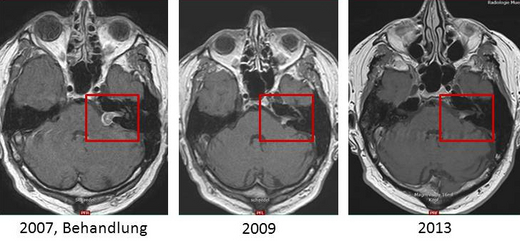Acoustic neuroma
The ERCM has already treated over 2,000 patients with acoustic neuromas and therefore offers extensive radiosurgical experience in this disease.
Here is an example of a Cyberknife treatment for acoustic neuroma over a 6-year period:

News & Publications ›
News & Publications ›
Cyberknife technology to treat acoustic neuroma
In this video, the treatment options of Cyberknife radiosurgery for patients with acoustic neuroma (vestibular schwannoma) are discussed together with our neurosurgical colleagues from the Klinikum Großhadern of the University of Munich (LMU).

Definition
The acoustic neuroma is one of the cells of the nerve sheath (Schwann sheath) outgoing benign nerve fiber growth. This mainly affects the nerve fibers of the auditory and vestibular nerve (vestibulocochlear nerve;. VIII cranial nerve), which establish the connection between the inner ear and brain.
The medically correct name of this disease is “vestibular schwannoma”, since the vestibular portion of the auditory and vestibular nerve is especially affected. The disease has its origin in the so-called ‘Schwann cells’ forming the sheath (myelin sheath) of the peripheral nerve fibers. Acoustic neuromas are benign tumors that do not form metastases (secondary tumors) and therefore do not affect any other organs and systems.

Causes
Causes of the development of acoustic neuromas are unknown, but a connection between the rare hereditary disease “Neurofibromatosis” (a genetic disease) and the acoustic neuroma are documented. If the acoustic neuroma with Recklinghausen’s disease (neurofibromatosis type 1) is associated, usually unilateral acoustic neuroma develops.
Patients suffering from type 2 neurofibromatosis, usually have bilateral acoustic neuromas. These benign tumors are rare and make 6% of all primary intracranial brain tumors. Acoustic neuromas occur in the skull base and grow slowly over a period of several years.

Symptoms
The symptoms can vary and depend on the size of the tumor and the affected cranial nerve. The most common signs of an acoustic neuroma include:
– Hearing deficiency and acute hearing loss
– Dizziness (vertigo), may be associated with nausea and balance disorders
– Tinnitus (subjectively perceived noise, ringing or whistling in the ears) – occurs in approximately 80% of cases.
The rare and non-specific symptoms include:
– Restriction of speech perception
– Headache, especially in the morning after wake up, when coughing, sneezing and vomiting
– Paralysis of the facial muscles and around the ears.
Tumors that have reached a certain size, can affect other cranial nerves or proximate locations and thus cause various symptoms. When the VII. Cranial nerve (facial nerve) is impaired, paralysis of the facial muscles, transient visual disturbances and disturbance of tear secretion usually occurs. The impairment of the fifth cranial nerve (trigeminal nerve) results, inter alia, in subjective discomfort in the face. Swallowing difficulty may occur if the IX. (Glossopharyngeal) and X (vagus) cranial nerve are affected. If the tumor presses on further increase in size not only to the adjacent cranial nerves, but also on the brain stem, which increases the intracranial pressure and results in vomiting, headache, and in extreme cases can even lead to unconsciousness.

Diagnosis
Most acoustic neuromas are diagnosed today as the reason for vertigo, acute hearing loss or as incidental findings during a magnetic resonance imaging of the skull (eg, headache). Family anamnesis is important in the case of a family history of neurofibromatosis.
If MRI is performed correctly, tumors with a diameter of 1-2 mm can be identified.
Other investigation methods are
– The hearing function measurement (audiometry)
– Auditory evoked potentials (medical, objective measuring method)
– Method for studying the caloric excitability of the vestibular organs.

Therapy of acoustic neuroma
The existing three different therapeutic approaches to the treatment of acoustic neuroma are:
– Microsurgical tumor removal
– Radiation (radiosurgery, e.g. Cyberknife, ZAP-X treatment)
– Follow-up with regular magnetic resonance imaging examinations
Information on radiosurgery (e.g. cyberknife treatment) of acoustic neuroma can also be found on the website of the acoustic neuroma interest group (interest group of those affected and interested): www.akustikus.de
Cyberknife treatment in Munich
For treatment requests, please use the contact form. Your request will be processed individually and quickly.


